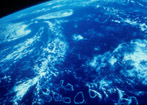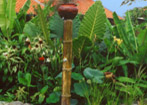Mbambanga / Sagharughombe, near Gizo
24th January - 8th February 2006
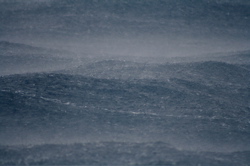
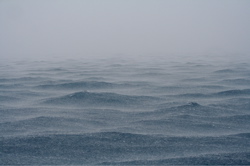
Finally cyclone season made its presence felt in our stretch of
the South Pacific with a ten day run of continuous rain and squalls
with gusts up to 40 knots at times. Cyclone Jim made its present
felt 600 miles south of us and we hoped that as the cyclone would
move, so too the weather would change. But for a week we were
contained between a trough to the south of us and a ridge to the
north, both belligerent and neither moving. It felt very familiar
– like the ‘bungiwaloo’ phenomenon, the eight
day winds we experienced several times in Fiji – except
this lasted ten days!! Our anchorage at Mbambanga gave us some
security during the heavier blows. The holding ground there is
great. But flooding became a severe problem over many parts of
the Solomons with rivers breaking their banks and gardens washing
away. This was an unexpectedly intense rainy season and became
almost a national crisis.
Buri Village, Ranongga and Jari Island
8th - 13th February 2006
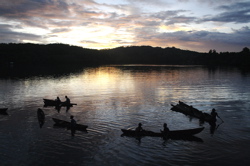
canoes surround us while anchored in Emu Harbour
We finally made it to Ranongga after all the
rain and wind of early February. Before departure, we made some
training maneuvres with Kitty and Starrlight each raising anchor,
piloting the ship around the reef marker and returning Heraclitus
to its starting position to drop anchor. Carol then piloted us
out through the pass beside Kennedy Island and on our way to Ranongga.
We arrived into Emu Harbour, Ranongga on Thursday morning. From
before dropping anchor to raising again early Sunday morning,
the ship was continuously surrounded by a flotilla of canoes,
many of which were eager to sell their fresh food or carvings.
There are some fine carvers on Ranongga and they did good business
with the Heraclitus!
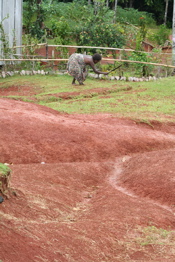
a lady tidies her garden
beside the church on Friday afternoon
The village there is called Buri and many of
the people are from Eddie’s tribe. It is also a Seventh
Day Adventist community. We spent Friday making two trips through
the village, up the hill to the church and schools, squelching
through mud after all the rainfall. The gardens are meticulous
with flower borders planted everywhere. We watched the women clean
up intensely, lifting every fallen leaf and frangipane around
the church, preparing for their worship which begins on Friday
evening. SDAs do not eat pig, smoke tobacco or chew betel nut.
Their teeth are eerily white.
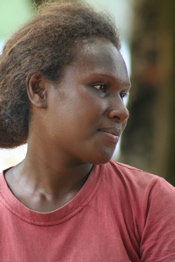
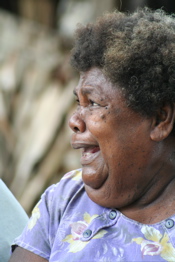
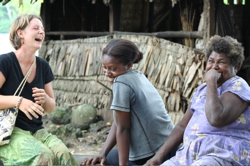
scenes in the cool shade
of a tree at Buri
We met one carver, Waldo, who
lived away from the village in the mangroves. He showed us a storyboard
carving he had made, outlining the legend of his great-grandfather,
Sipata. The carving showed a tomoko (war canoe) hidden in a cave,
an altar at which the tribe’s priest would make offerings
of pigs before and after a head-hunting raid, the mythical bird
that would guide the war canoe and Sipata on task with his axe
and shield. Waldo showed us an original shield – woven from
natural fibres and bearing scars of axe blade attacks. He also
had an original ngzuzu – the Solomon figure that sits at
the front of the tomoko. It was old and worn, but the form was
easily recognizable.
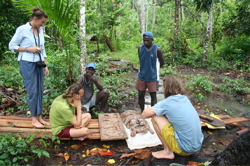
Waldo shows his storyboard
carving to Carol, Michel and Sharman

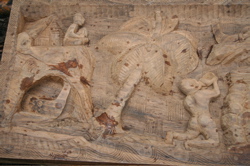
the storyboard depicts a
headhunting scene
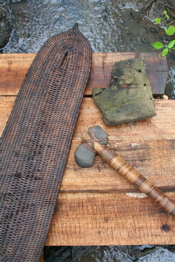
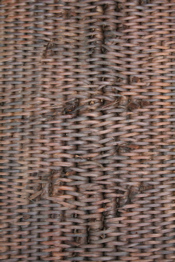

the shield, axe and ngzuzu
On Saturday, while the community
spent the better part of the day inside the church, we stayed
offshore and explored underwater around Woi, the island just off
the north east tip of Ranongga. We found a lot of bleaching but
we also saw two turtles, a few small white tip sharks and a few
giant trevallies plus a five foot long giant clam.
Sunday morning, we weighed anchor and made for Jari – the
small island at the end of the chain of islands running north
west from Gizo. Danny Kennedy, a dive operator who has been based
here in Gizo for 19 years and who is now the local Minister for
Transportation, bought this island and had told us of the high
biodiversity on the reef here. Gerry Allen, tropical ichthyologist
extraordinaire, dived here last year and came up with the second
highest fish species count in the Indo-Pacific! The reef looks
good but again the elevated sea temperature is taking its toll
– corals and even anemones are bleaching, leaving vivid
clownfish looking very out of place amongst white tentacles.
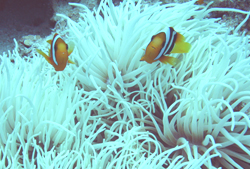
We spent Sunday night at sea and had our first
dinner on deck after weeks of being cooped up below. The sun set
gloriously behind Ranongga, the almost full moon appeared between
rose clouds and we drifted through the twilight. We anchored Monday
morning in Gizo harbour and began to stock up.

We saw Eddie on Monday along with Stanley,
his father, and Ronnie his uncle who is holding the family land
on Raromana. Sadly Eddie had been unable to join us in Ranongga
– there was no way out of Nusa Simbo with the channel closed
at both ends. They had to cut many trees around the island when
the wind started to blow in order to avoid damaging houses and
Eddie told us that the village now looks like a desert. He also
told us that in Legana, where the ship was anchored during our
Simbo celebrations, several houses were toppled by the wind and
waves. We are very lucky that we had calm weather during our time
there. Eddie helped raise our Zodiac for the last time before
he headed back to Simbo and the Heraclitus lifted anchor
for Wagina.
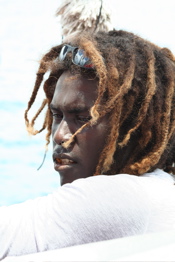
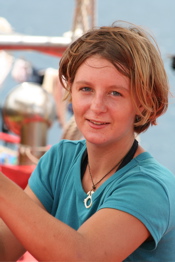
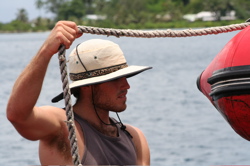
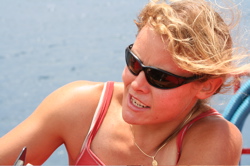
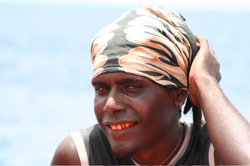
the boat team in action
with Eddie's brother Clifford watching on
|



